Serving 1,411 students in grades 9-12, East Chapel Hill High School ranks in the top 5% of all schools in North Carolina for overall test scores (math proficiency is top 10%, and reading proficiency is top 10%).
The percentage of students achieving proficiency in math is 80-84% (which is higher than the North Carolina state average of 51%). The percentage of students achieving proficiency in reading/language arts is 86% (which is higher than the North Carolina state average of 50%).
The student:teacher ratio of 16:1 is higher than the North Carolina state level of 15:1.
Minority enrollment is 52% of the student body (majority Asian and Hispanic), which is lower than the North Carolina state average of 57% (majority Black and Hispanic).
Quick Stats (2025)
- Grades: 9-12
- Enrollment: 1,411 students
- Student:Teacher Ratio: 16:1
- Minority Enrollment: 52%
- Graduation Rate: 96% (Top 5% in NC)
- Overall Testing Rank: Top 5%
- Math Proficiency: 80-84% (Top 10%)
- Reading Proficiency: 86% (Top 5%)
- Science Proficiency: 20-29% (Btm 50%)
- Source: National Center for Education Statistics (NCES), NC Dept. of Education
Top Rankings
East Chapel Hill High School ranks among the top 20% of public schools in North Carolina for:
Category
Attribute
Overall Rank
Math Proficiency
Reading/Language Arts Proficiency
Graduation Rate
Diversity
School Overview
East Chapel Hill High School's student population of 1,411 students has declined by 5% over five school years.
The teacher population of 88 teachers has stayed relatively flat over five school years.
Grades Offered
Grades 9-12
Total Students
1,411 students
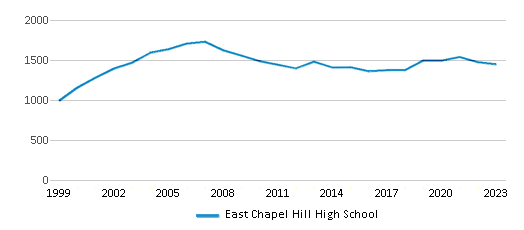
Gender %
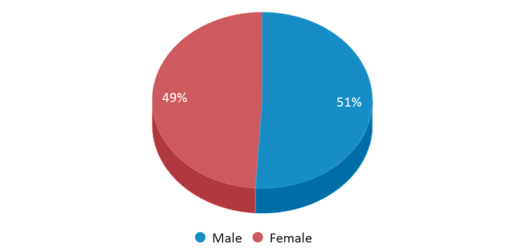
Total Classroom Teachers
88 teachers
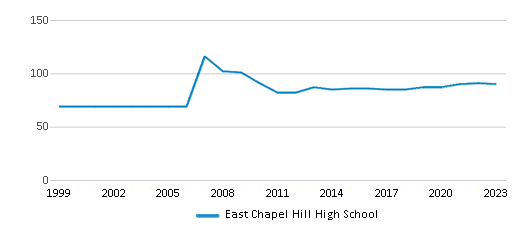
Students by Grade
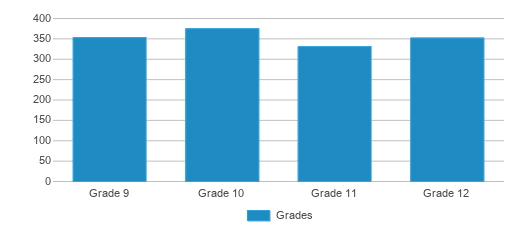
School Rankings
East Chapel Hill High School ranks within the top 5% of all 2,617 schools in North Carolina (based off of combined math and reading proficiency testing data).
The diversity score of East Chapel Hill High School is 0.70, which is less than the diversity score at state average of 0.71. The school's diversity has stayed relatively flat over five school years.
Overall Testing Rank
#87 out of 2617 schools
(Top 5%)
(Top 5%)
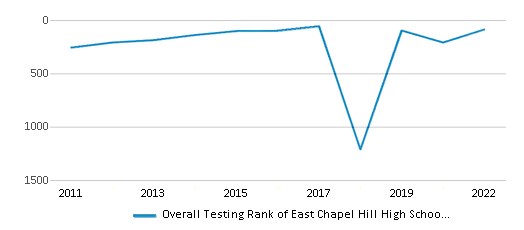
Math Test Scores (% Proficient)
80-84%
51%
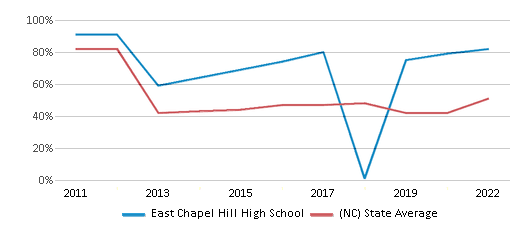
Reading/Language Arts Test Scores (% Proficient)
86%
50%
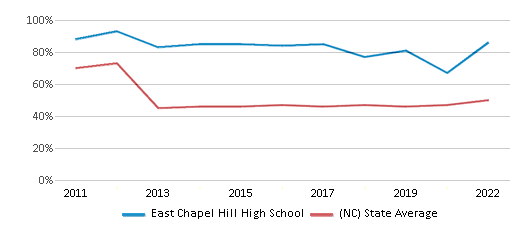
Science Test Scores (% Proficient)
20-29%
63%
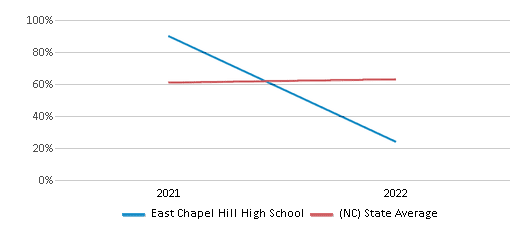
Student : Teacher Ratio
16:1
15:1
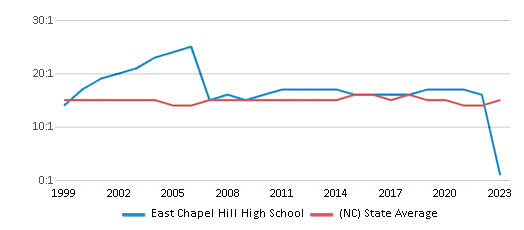
American Indian
n/a
1%
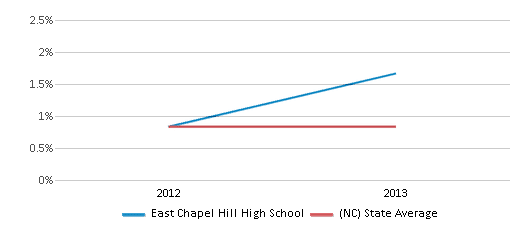
Asian
21%
4%
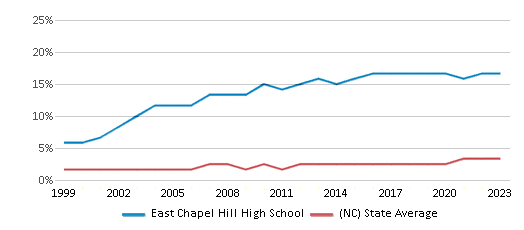
Hispanic
13%
21%
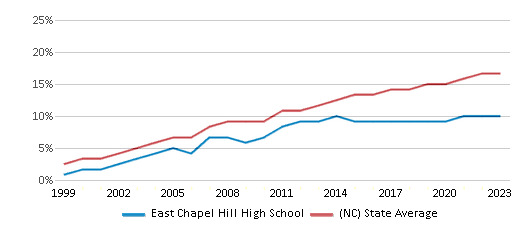
Black
10%
25%
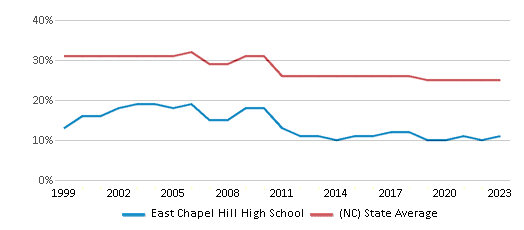
White
48%
43%
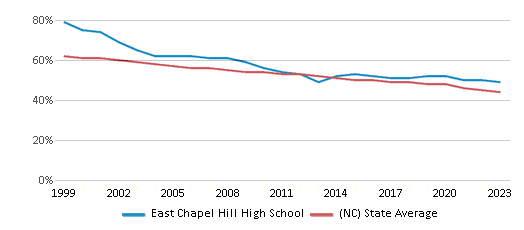
Hawaiian
n/a
n/a
Two or more races
8%
6%
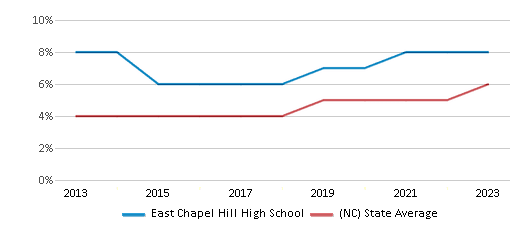
All Ethnic Groups
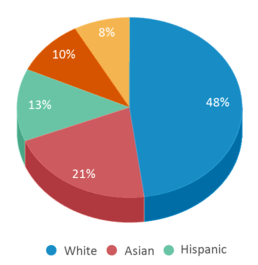

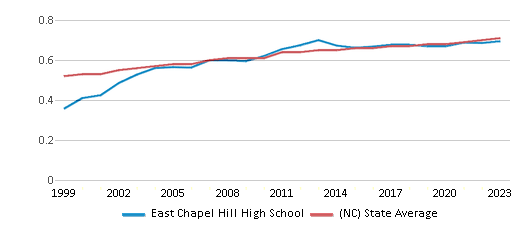
Graduation Rate
96%
86%
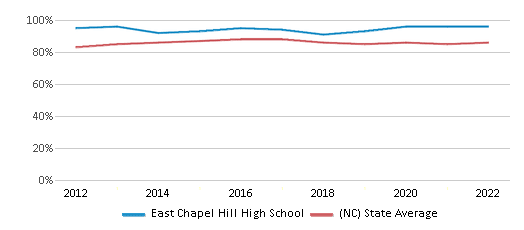
Participates in the National School Lunch Program (NSLP)
Yes
Eligible for Free Lunch
21%
68%
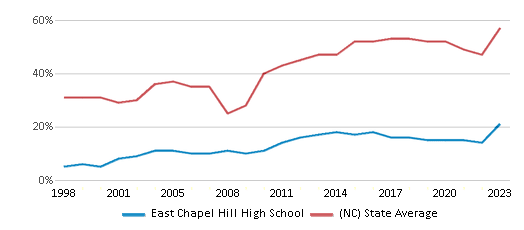
Eligible for Reduced Lunch
1%
1%
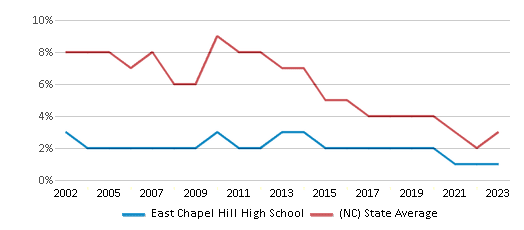
School Statewide Testing
School District Name
Source: National Center for Education Statistics (NCES), NC Dept. of Education
Profile last updated: 02/09/2025
Frequently Asked Questions
What is East Chapel Hill High School's ranking?
East Chapel Hill High School is ranked #87 out of 2,617 schools, which ranks it among the top 5% of public schools in North Carolina.
What schools are East Chapel Hill High School often compared to?
East Chapel Hill High Schoolis often viewed alongside schools like Chapel Hill High School, Carrboro High School by visitors of our site.
What percent of students have achieved state testing proficiency in math and reading?
80-84% of students have achieved math proficiency (compared to the 51% NC state average), while 86% of students have achieved reading proficiency (compared to the 50% NC state average).
What is the graduation rate of East Chapel Hill High School?
The graduation rate of East Chapel Hill High School is 96%, which is higher than the North Carolina state average of 86%.
How many students attend East Chapel Hill High School?
1,411 students attend East Chapel Hill High School.
What is the racial composition of the student body?
48% of East Chapel Hill High School students are White, 21% of students are Asian, 13% of students are Hispanic, 10% of students are Black, and 8% of students are Two or more races.
What is the student:teacher ratio of East Chapel Hill High School?
East Chapel Hill High School has a student ration of 16:1, which is higher than the North Carolina state average of 15:1.
What grades does East Chapel Hill High School offer ?
East Chapel Hill High School offers enrollment in grades 9-12
What school district is East Chapel Hill High School part of?
East Chapel Hill High School is part of Chapel Hill-Carrboro City Schools School District.
School Reviews
5 6/30/2010
Overall, the teachers are very good. However, like anywhere there are exceptions due to bad tenure, etc. The selection of courses is broad, including Honors and AP's. Academics is very extremely competitive. This school has an exceptionally strong music department. All sports other than football are excellent. Basketball, Soccer, Lacrosse and tennis are more popular than football. The facility and grounds are relatively new and very well-maintained. Good choice of healthy, contemporary lunch food. Very diverse and respectful student body. Overall a very liberal-leaning school, like the town (see school newspaper). However, there are some teachers with moderate views. As in most cases/places, better to keep your politics to yourself. It's a very driven environment, so most importantly, it needs to be a good match for a student that's comfortable with that type of high expectations.
Review East Chapel Hill High School. Reviews should be a few sentences in length. Please include any comments on:
- Quality of academic programs, teachers, and facilities
- Availability of music, art, sports and other extracurricular activities
Recent Articles

What Is A Charter School?
Explore the world of charter schools in this comprehensive guide. Learn about their history, how they operate, and the pros and cons of this educational innovation. Discover key facts about charter schools, including admission policies, demographics, and funding, as well as what to look for when considering a charter school for your child.

10 Reasons Why High School Sports Benefit Students
Discover the 10 compelling reasons why high school sports are beneficial for students. This comprehensive article explores how athletics enhance academic performance, foster personal growth, and develop crucial life skills. From improved fitness and time management to leadership development and community representation, learn why participating in high school sports can be a game-changer for students' overall success and well-being.

February 05, 2025
Understanding the U.S. Department of Education: Structure, Impact, and EvolutionWe explore how the Department of Education shapes American education, from its cabinet-level leadership to its impact on millions of students, written for general audiences seeking clarity on this vital institution.









